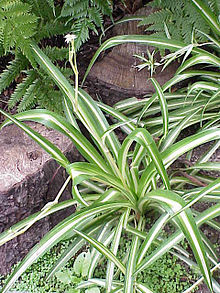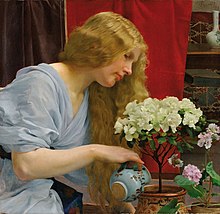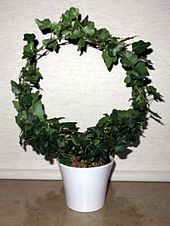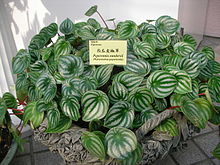Houseplant


A houseplant (also a potted plant , in Austria a flower stick ) is a plant that is grown indoors .
Houseplants are usually kept indoors as ornamental plants all year round, unlike ornamental plants that are kept in parks and gardens, or agricultural crops . Even potted plants are usually housed in rooms only during the cooler weeks of the year and are available in the summer months outdoors.
Indoor plants are usually grown in pots , as there is no natural soil available in closed rooms . In the area of interior greening , there are seldom bedding systems , sometimes with connection to the natural soil.
properties
Species that are able to survive indoors due to their adaptation to the climate of their natural vegetation are suitable as houseplant. Housing and care requirements of the corresponding species or variety - for example, temperature, light, water supply and other factors - must be complied with.
Such species are selected and grown as indoor plants that are well adapted to the conditions in human rooms. All over the world, these conditions usually vary between 18 and 30 ° C air temperature and around a medium humidity.
However, if indoor plants need higher air humidity, this is helped by spraying with water ( atomization , misting) locally at the placement point.
Indoor plants play an important role in human living space. They bind pollutants such as formaldehyde , toluene and ammonia from the air , convert some of them into carbon compounds and thus “filter” the living air. In this context, scientific experiments were undertaken by NASA to compare hermetically sealed rooms with and without houseplants.
There is still a belief that placing plants in the bedroom is potentially harmful to health . The reason for this is the oxygen consumption and the accumulation of carbon dioxide at night due to the metabolism of the plant. Indeed, a plant also consumes oxygen, but this happens all the time, with oxygen production coming to a standstill at night due to the lack of light. With many plants in a small space, this change can lead to a measurable effect in the darker times, but it can only cause discomfort in some people.
Cultural history

The ancient Egyptians grew plants in containers, the Greeks and Romans cultivated laurel trees in earthen vessels. In China, potted plants were shown at garden exhibitions over 2500 years ago. How far living spaces were decorated at that time is unknown.
Up until the 17th century there was little evidence of indoor plant cultivation in Central Europe. One explanation is the low standard of living at the time. Using the window sill in the living room as a plant shelter meant less light, storage space and freedom of movement. Even in the often dark and unheated adjoining rooms there were almost no plants.
Plant breeding developed in the late 17th and 18th centuries. It was now possible to cultivate plants that the researchers and botanists brought to Europe from their ship expeditions from South America, Africa, Asia and Australia. These novelties were drawn and presented in the botanical gardens and in private court collections. Large sections of society have long rejected the purchase of houseplants due to the usefulness of thinking and poverty. With the beginning of the bourgeois era at the end of the 18th century, but especially from the Biedermeier period , flower tables became part of the salons. Nature now beautified living spaces. What began around 1800 as a flower stand and jardinière developed into representative round sofas in the middle of the 19th century, with palm trees often planted in the middle. Architectural reforms and the development of new processes for glass production ensured the use of larger windows and thus an improved supply of light in the living spaces. This allowed indoor plants to flourish more and more often. At the end of the 19th century, the range already included begonias , cineraria, clivia , cyclamen and flamingo flowers , but also ornamental foliage plants such as ferns , fir , ornamental asparagus , green lilies , bow hemp , ivy and rubber trees .
A rethink took place with the Bauhaus architecture . Large, often ceiling-high windows ensured a seamless transition from the interior to the garden. Flower pots for decorating the interior were regarded by intellectual circles as superfluous trinkets even in the 1970s.
Today indoor or office plants are valued again. They visually improve the living and working atmosphere by conveying a lifestyle feeling. They also improve the room climate and absorb pollutants that are gradually released into the room air from carpets, wall paint or furniture.
One of the oldest houseplants
One of the oldest houseplants is the myrtle . As early as the 16th century it became fashionable in Germany to decorate brides with myrtle wreaths. A custom developed for the young wife to plant a branch from the bridal wreath in the ground and let it root. The green plant was seen as an indicator of marital happiness and was especially cherished. So the myrtle found its way into living rooms.
The origin of indoor plants
The natural range of plant species, the varieties of which are used as house plants, allows important conclusions to be drawn about their keeping requirements. Plants from tropical rainforests, unlike those from temperate zones, do not require any rest periods. On the other hand, their requirements for humidity are usually particularly high. A more precise knowledge of the natural vegetation space of a plant is therefore helpful for maintenance.
Tropical rain forest
The vast majority of the plant species kept as indoor plants come from the tropical rainforest and the adjacent areas. The day length there is constant about twelve hours. Precipitation is evenly distributed over the year. The average daily temperature depends on the respective altitude. In tropical forests, which are not at altitudes above 600 meters, it is usually between 24 and 28 degrees Celsius throughout the year. In higher-lying rainforests, the so-called tropical mountain forests, it sometimes only averages 10 degrees Celsius.
The light conditions under which the respective plant species thrive depend on the respective vegetation levels. Plants that grow near the ground are usually very shade-friendly species. In contrast, climbing plants and epiphytically growing species require more light.
Typical plant species of the tropical rainforest that are cared for as house plants are bromeliads , orchids and philodendrons . They are suitable for keeping as houseplant because they usually look attractive all year round and these plants do not need a separate rest period.
Moist forests
In contrast to the tropical rainforests, the alternately humid or rain-green forests have rainy and dry periods. The species occurring there are adapted to these dry periods and have periods of growth and rest. Successful care of these species requires that these rest periods are observed.
Typical plant species of the damp forests, the varieties of which are cultivated as house plants, are knight's star and the Clivien, which has been introduced as a house plant since 1850 .
Open savannah landscape
The open savannah landscape, which can be found in both the tropics and the subtropics , is more finely divided into wet savannah , dry savannah and thorn bush savannah . Plant species in this habitat are very well adapted to temporary drought and low humidity . They are mostly succulents and cacti . For many species, however, it is important to note that cold storage may be necessary in winter in order to achieve flowering success in the next year.
In addition to the cacti, various types of the aloes , agaves , crassula , echeveria , euphorbia and sansevieria have found distribution as indoor plants.
subtropics
Characteristic for the subtropics are a day length that changes according to the season and a relatively mild winter with abundant rainfall. During the summer, precipitation occasionally occurs only sporadically and very high temperatures can be reached. Myrtle and oleander, as well as some species of Ficus, are houseplants that come from this vegetation zone.
Temperate zone
Very few species of the plants kept as houseplants come from the temperate climate zone. Typical representatives are cultivated forms of ivy as well as Saxifraga stolonifera and Carex brunnea . They all only thrive if they are kept as cool as possible.
The culture of house plants
The ornamental plant cultivation division is dedicated to the propagation and cultivation of indoor plants as part of the horticultural profession . In production facilities, indoor plants are usually propagated in greenhouses and cultivated further until the respective sales stage (e.g. certain size, flowering stage). Cultivation takes place in soil and hydroponics or in a culture substrate made of porous, fired clay granulate . After that, they are offered by service horticulture companies such as B. retail nurseries or garden centers sold to customers.
Classification of indoor plants
A distinction can first be made between flowering potted plants and green plants. The former have their ornamental value through mostly recurring flowers, the second group through attractive, possibly colored leaves. Combinations of plants with a high flowering value and decorative foliage are also common.
Flowering potted plants
- Azalea ( Rhododendron simsii )
- Single leaf ( Spathiphyllum - hybrids )
- Chinese rose hibiscus ( Hibiscus rosa-sinensis )
- Poinsettia ( Euphorbia pulcherrima )
- African violets ( Saintpaulia ionantha )
- Cyclamen ( Cyclamen persicum )
Green or leafy plants
- Weeping fig ( Ficus benjamina )
- Bow hemp ( Sansevieria )
- Ivy ( Hedera helix )
- Efeutute ( Epipremnum pinnatum )
- Delicious window leaf ( Monstera deliciosa )
- Rubber tree ( Ficus elastica )
- Croton ( Codiaeum variegatum )
- Peperomia ( Peperomia )
- Schefflera
- Indoor aralia ( Fatsia japonica )
- Zamioculcas zamiifolia
Flowering house plants with decorative foliage
- Rex begonias ( Begonia Rex hybrids )
- Bromeliads , e.g. B. Aechmea fasciata
- Glossy bulb ( Aphelandra squarrosa )
- Green lily ( Chlorophytum comosum )
- Zebra ampelkraut ( Tradescantia zebrina )
- Cape Linden ( Sparrmannia africana )
Indoor plants selection
Here is a selection of indoor plants - sorted according to care requirements.
Shady areas

- Cobbler palms ( Aspidistra )
- Window leaves ( Monstera )
- Green lily ( Chlorophytum comosum )
- Strahlenaralie ( Schefflera arboricola )
- Dragon trees ( Dracaena )
- Philodendron
- Piston thread ( Aglaonema commutatum )
- Efeutute ( Epipremnum )
- Dieffenbachia ( Dieffenbachia )
Partially shaded areas
- Zamioculcas
- Klivie
- Yucca , of the many species actually only the ( Yucca elephantipes )
- Rubber tree ( Ficus elastica )
- Ivy ( Hedera helix )
- Flamingo flower
- Begonias ( Begonia spec.)
- Commelina plants
- Arrowroot
- Wild wine, or called Klimme, ( Cissus )
- Colored nettle ( Solenostemon scutellarioides )
- Club lily Cordyline spec.
- Golden fruit palm ( Chrysalidocarpus lutescens )
- Calla
- some tropical ferns
Light areas
- Elephant foot (formerly Beaucarnea now Nolina )
- Weeping fig ( Ficus benjamina )
- Bromeliads
- Orchids (some species suitable as indoor plants)
- Croton , wonder shrub (genus Codiaeum )
- Coffee plant
- Cyprus grass and papyrus ( Cyperus )
- Hibiscus ( hibiscus )
- some palm species, e.g. B. Kentia palms
- African violets ( Saintpaulia )
Sunny windows
Cool rooms
- Cyclamen ( Cyclamen persicum hybrids)
- Primroses ( Primula , various species)
- Bulb flowers
- Cacti and succulents in winter
- Common fir ( Araucaria heterophylla )
- Cape Linden ( Sparrmannia africana )
- Ornamental asparagus ( Asparagus , various types)
- Camellia ( Camellia japonica )
- Azalea ( rhododendron simsii hybrids) and ( rhododendron japonica hybrids)
- Hydrangea ( Hydrangea macrophylla )
See also
literature
- Karl Alexis Waller: Der Stubengärtner, ... 3rd, greatly increased and improved edition. Voigt, Sondershausen [u. a.] 1821 ( digitized version )
- Max Jubisch : Instructions for indoor gardening , Kittlitz, 1880 ( limited preview in the Google book search)
- Fritz Encke: cold and warm house plants . 2nd Edition. Verlag Eugen Ulmer, Stuttgart 1987, ISBN 3-8001-6191-5
- Moritz Bürki, Marianne Fuchs: picture atlas of potted plants for rooms and balconies - profiles and tables from A - Z , Verlag Eugen Ullmer, Stuttgart 2004, ISBN 3-8001-4654-1
- Alfred Byrd Graf: Tropica - Color Cyclopedia of Exotic Plants and Trees. Roehrs Company, New Jersey 1981 (second edition), ISBN 0-911266-16-X
- Bernhard Rosenkranz: Gardening without a garden. Enjoyment of balcony and indoor plants . Rowohlt, Reinbek near Hamburg 1987, ISBN 3-499-18347-1
- Dietrich Frohne, Hans Jürgen Pfänder: Poison Plants , 5th edition, Wissenschaftliche Verlagsgemeinschaft Stuttgart, 2004, ISBN 978-3-8047-2060-2 .
- Jacqueline Kupper, Daniel Demuth: Poisonous plants for small and domestic animals: Recognize plants - Name poison - Correct therapy , Enke, Stuttgart 2010, ISBN 978-3-8304-1034-8 .
- Lutz Roth, Max Daunderer, Kurt Kotmann: Poisonous plants - plant poisons : occurrence, effect, therapy; allergic and phototoxic reactions (with a special section on poisonous animals), Nikol, Hamburg 2008, ISBN 978-3-86820-009-6 .
- Heike Boomgaarden: Poisonous plants in the house and garden . Franckh-Kosmos, Stuttgart 2010, ISBN 978-3-440-12262-4 .
Individual evidence
- ↑ BC Wolverton: Live healthier with house plants. Egmont vgs Verlagsgesell., 1997, ISBN 3-8025-1343-6 .
- ↑ ddp: Plants in the bedroom use oxygen at night. Aachener Zeitung, February 13, 2009, accessed on October 13, 2017 (German).







